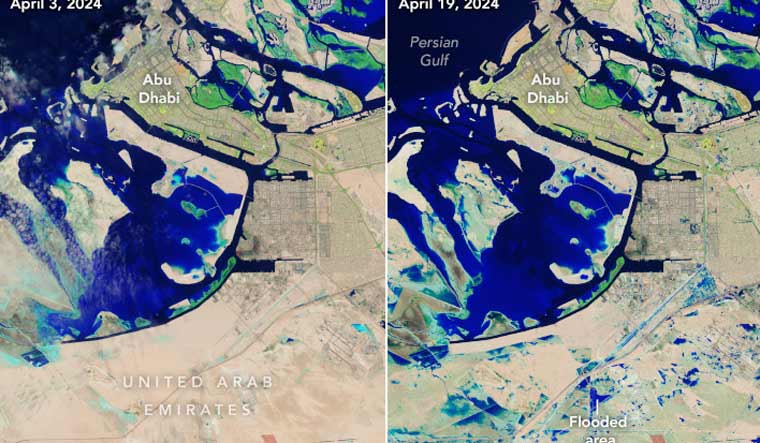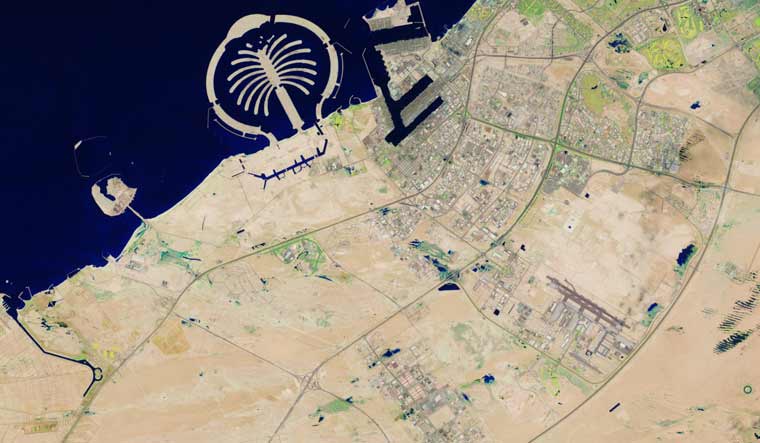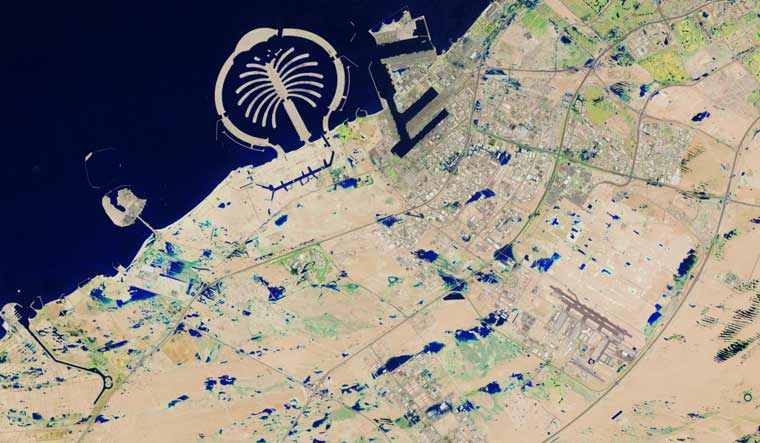Images by Landsat 9 showed many areas were still underwater
By Sarah Sebastian Updated: April 23, 2024


Abu Dhabi. Before and after the floods | NASA
The US space agency NASA has released satellite images captured by the Landsat 9 satellite that shows large, lingering pools of floodwater in Dubai, which witnessed heavy showers last week.
According to the Earth Observatory, when Landsat 9 passed over the region for the first time since the desert storm, many areas were still under water though it was three days since the rains subsided.
The image shows flooding in Jebel Ali, a town 35 kilometres southwest of Dubai. Flooding can be seen in the industrial area of Jebel Ali just south of the port and near the green resorts and parks south of Palm Jebel Ali.

The US space agency NASA has released satellite images captured by the Landsat 9 satellite that shows large, lingering pools of floodwater in Dubai, which witnessed heavy showers last week.
According to the Earth Observatory, when Landsat 9 passed over the region for the first time since the desert storm, many areas were still under water though it was three days since the rains subsided.
The image shows flooding in Jebel Ali, a town 35 kilometres southwest of Dubai. Flooding can be seen in the industrial area of Jebel Ali just south of the port and near the green resorts and parks south of Palm Jebel Ali.

Dubai's Jebel Ali area before the floods


Jebel Ali after the floods
The satellite images also captured parts of Abu Dhabi, the UAE’s capital city, inundated. While the images on April 3 show a clearer image, those of April 19 show water covering the Sheikh Zayed Road, a major thoroughfare that runs through Dubai and Abu Dhabi. Patches of flooded areas are also visible in Khalifa City and Zayed City, residential areas southeast of Abu Dhabi’s downtown.
The images offer a clear view as the water is seen as pools of deep blue as compared to the region’s typically dry ground, which appears tan or light brown.
Normal life was thrown off tracks in the Emirate after about 25cm of rain - roughly twice the UAE's yearly average - fell in a single day. Roads were submerged, malls flooded and air traffic was disrupted. Though Dubai's Met agency had warned of the impending rains, the desert region's weather infrastructure struggled to prepare for the worst rain since 1949.
The Emirate received a record rainfall over the last two days with the National Centre of Meteorology (NCM) calling the rains "an exceptional event in the UAE's climate history since the start of recording climate data".
The showers which began on Monday flooded the streets after which schools were suspended and government employees were forced to work from home.
Airports witnessed chaos as showers submerged the taxiway and passengers struggled to reach terminals through the floodwater covering surrounding roads.
The satellite images also captured parts of Abu Dhabi, the UAE’s capital city, inundated. While the images on April 3 show a clearer image, those of April 19 show water covering the Sheikh Zayed Road, a major thoroughfare that runs through Dubai and Abu Dhabi. Patches of flooded areas are also visible in Khalifa City and Zayed City, residential areas southeast of Abu Dhabi’s downtown.
The images offer a clear view as the water is seen as pools of deep blue as compared to the region’s typically dry ground, which appears tan or light brown.
Normal life was thrown off tracks in the Emirate after about 25cm of rain - roughly twice the UAE's yearly average - fell in a single day. Roads were submerged, malls flooded and air traffic was disrupted. Though Dubai's Met agency had warned of the impending rains, the desert region's weather infrastructure struggled to prepare for the worst rain since 1949.
The Emirate received a record rainfall over the last two days with the National Centre of Meteorology (NCM) calling the rains "an exceptional event in the UAE's climate history since the start of recording climate data".
The showers which began on Monday flooded the streets after which schools were suspended and government employees were forced to work from home.
Airports witnessed chaos as showers submerged the taxiway and passengers struggled to reach terminals through the floodwater covering surrounding roads.
No comments:
Post a Comment